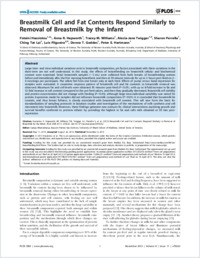Breastmilk cell and fat contents respond similarly to removal of breastmilk by the infant
Université de Fribourg
- Hassiotou, Foteini School of Chemistry and Biochemistry, Faculty of Science, The University of Western Australia, Perth, Australia - School of Anatomy, Physiology and Human Biology, Faculty of Science, The University of Western Australia, Perth, Australia
- Hepworth, Anna R. School of Chemistry and Biochemistry, Faculty of Science, The University of Western Australia, Perth, Australia
- Williams, Tracey M. School of Chemistry and Biochemistry, Faculty of Science, The University of Western Australia, Perth, Australia
- Twigger, Alecia-Jane School of Chemistry and Biochemistry, Faculty of Science, The University of Western Australia, Perth, Australia - School of Anatomy, Physiology and Human Biology, Faculty of Science, The University of Western Australia, Perth, Australia
- Perrella, Sharon School of Chemistry and Biochemistry, Faculty of Science, The University of Western Australia, Perth, Australia
- Lai, Ching Tat School of Chemistry and Biochemistry, Faculty of Science, The University of Western Australia, Perth, Australia
- Filgueira, Luis School of Anatomy, Physiology and Human Biology, Faculty of Science, The University of Western Australia, Perth, Australia - Anatomy Unit, Department of Medicine, University of Fribourg, Switzerland
- Geddes, Donna T. School of Chemistry and Biochemistry, Faculty of Science, The University of Western Australia, Perth, Australia
- Hartmann, Peter E. School of Chemistry and Biochemistry, Faculty of Science, The University of Western Australia, Perth, Australia
-
06.11.2013
Published in:
- PLoS ONE. - 2013, vol. 8, no. 11, p. e78232
English
Large inter- and intra-individual variations exist in breastmilk composition, yet factors associated with these variations in the short-term are not well understood. In this study, the effects of breastfeeding on breastmilk cellular and biochemical content were examined. Serial breastmilk samples (~5 mL) were collected from both breasts of breastfeeding women before and immediately after the first morning breastfeed, and then at 30-minute intervals for up to 3 hours post-feed on 2–4 mornings per participant. The infant fed from one breast only at each feed. Effects of pump versus hand expression for samples were evaluated. A consistent response pattern of breastmilk cell and fat contents to breastmilk removal was observed. Maximum fat and cell levels were obtained 30 minutes post-feed (P0.01), with up to 8-fold increase in fat and 12-fold increase in cell content compared to the pre-feed values, and then they gradually decreased. Breastmilk cell viability and protein concentration did not change with feeding (P>0.05), although large intra-individual variability was noted for protein. Expression mode for samples did not influence breastmilk composition (P>0.05). It is concluded that breastmilk fat content, and thus breast fullness, is closely associated with breastmilk cell content. This will now form the basis for standardization of sampling protocols in lactation studies and investigation of the mechanisms of milk synthesis and cell movement into breastmilk. Moreover, these findings generate new avenues for clinical interventions exploring growth and survival benefits conferred to preterm infants by providing the highest in fat and cells milk obtained at 30 min post-expression.
- Faculty
- Faculté des sciences et de médecine
- Department
- Département de Médecine
- Language
-
- English
- Classification
- Biological sciences
- License
- License undefined
- Identifiers
-
- RERO DOC 209461
- DOI 10.1371/journal.pone.0078232
- Persistent URL
- https://folia.unifr.ch/global/documents/303282
Statistics
Document views: 39
File downloads:
- fil_bcf.pdf: 42
